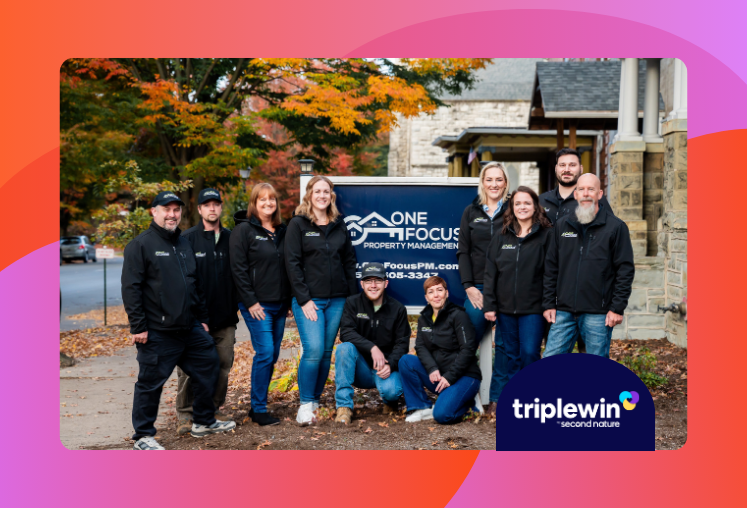Mark Brower is the owner and designated broker of Mark Brower Properties. He has over 20 years of experience in property management and investing, and lives in Mesa, Arizona. Mark is a Second Nature Triple Win Mentor.
Sales and marketing is a tough expense to swallow for most small businesses owners. That’s why it’s important to have a target customer acquisition cost (CAC), which will help you keep your go-to-market spending at a level that drives success while still allowing your business to be profitable. It will also give you data-backed confidence in your spending, knowing that it’s driving results.
There are some basic economic principles that I think all property management business leaders should be applying in order to calculate their maximum customer acquisition cost. In this article, I’ll walk you through what customer acquisition cost is, how it relates to new present value, why it’s helpful to think of sales and marketing costs in terms of future profits, and how to increase your max CAC to help grow your business.
Defining max CAC
Customer acquisition cost (CAC) is the total amount of investment it takes to bring a new client under management. It’s a calculation of all of the marketing and sales expenses you need to put out in order to bring each new customer in. CAC is particularly useful in determining the success of your marketing efforts.
Your max CAC is the highest amount you can profitably invest in new client acquisition. While CAC is just a measure of what’s currently happening, max CAC is the highest number that you’re able to spend while covering costs and getting a return on capital. If you exceed that max CAC, it’s time to pump the brakes a bit and reevaluate.
Do you know your CAC?
It’s my strong belief that property management company owners frequently underestimate how much they can profitably spend to acquire new clients. In fact, I suspect that most property managers don’t even know what they are spending to bring in new doors.
Most property managers, even if they were willing to be completely open and candid with you, would not have a great sense of how much money they spend to bring in new customers. Many probably have no idea at all. If I had to guess, I suspect most would probably tell you that they just want to spend as little as possible.
The most business-savvy might take their total marketing budget and divide it by the number of new contracts they sign each year, just to get a rough estimate. At the end of the day, it’s basically just a gut feeling or, at best, some fuzzy math.
I think for many PMs, not having a max CAC stems from not having the data that contributes to it. For example, if you don’t know your lifetime revenue from new clients—and the lifetime margin for each property—how can you possibly calculate the amount of money you can spend to generate that revenue?
Understanding net present value in business
I’m of the strong opinion that we can and should be using an economic concept called net present value (NPV) to calculate out the maximum amount we should be paying any individual new client.
Net present value is a discounted look at what you should be willing to spend to get a return. NPV recognizes a basic truth: a dollar today is worth more than a dollar tomorrow, thanks to inflation. When businesses evaluate investments, they use NPV to compare the value of spending money now against the future returns that spending will generate.
For example, a $10,000 contract paid out over the next five years is worth significantly less than a contract where all $10,000 is paid in full up front. That’s because in five years, when the final payment is made, that $2,000 installment will have less buying power. Net present value is the equivalent value today of that $10,000, five-year contract.
Max CAC as the net present value of future profits
This concept is particularly relevant in property management, where upfront client acquisition costs generate revenue streams that can last for years. Using net present value to understand your maximum CAC is a bit unconventional, but it’s actually very revealing, especially for those property managers who don’t currently have a good sense of their CAC. Basically, your maximum CAC should be the net present value of the revenue from an average account.
There are a few things you’ll need to know before trying to calculate NPV, though. First of all, you need to be confident in your churn rate and lifetime value (including value broken out for each year) in order to do these calculations. If you calculate that you can spend $1,000 per client, but then your churn rate increases, suddenly you’ve overpaid for a contract that’s not going to earn back the money.
Measuring return on capital
Property management is a relatively mature market, and in mature markets, businesses look at profits in terms of return on capital. Just as the property owners we work for have capital that they’re looking for a return on, we as business owners also have capital in our businesses that we should be looking for a return on.
As a business owner, you should set a goal for the return on capital of your business. For many businesses, this tends to fall in the 15-20% range. That’s the profit margin you want to achieve, and you’re going to factor that profit in when you start calculating your max CAC.
Calculating NPV for property management
Once you understand the components of NPV, calculating it actually isn’t too complicated. For a business like property management, it can be pretty straightforward. I think it’s helpful to look at an example to really illustrate the math here.
Let’s look at an example
Let's say your company generates $1,300 in annual profit per door, and clients typically stay with you for four years (25% churn rate). If you want a 20% return on your investment (your discount rate), you'll calculate the present value of each year's revenue stream as follows:
For Year 1: $1,300 ÷ 1.20 = $1,083
For Year 2: $1,300 ÷ 1.44 = $903
For Year 3: $1,300 ÷ 1.728 = $752
For Year 4: $1,300 ÷ 2.074 = $627
The sum of these discounted values ($3,365) represents the maximum you could spend today to acquire a client while still achieving your target 20% return (on the cost of acquisition).
That number might strike you as very high, and you wouldn’t be alone. When you actually do the math, max CAC is typically much higher than what most property managers intuitively believe they can spend on client acquisition.
Think of this calculation as your "money machine" calibration. Your property management business is your money machine, and you're essentially determining how much you can put into one side of the machine (client acquisition) to get your desired return out the other side (future profits).
Understanding your max CAC through NPV analysis transforms marketing from a cost center into a strategic investment vehicle. That’s why it’s so important to do these calculations; it gives you the confidence to invest in sales and marketing, knowing that you’re going to see a return in the future.
Growing your max CAC
The more profitable your business is, the more you can afford to spend on customer acquisition. The most direct way to increase max CAC, then, is to increase profitability through as many avenues as possible. With tools like Second Nature, and especially their new Group Rate Internet benefit, you can increase profitability, which will in turn have a huge impact on your max CAC. Suddenly you can not only spend more on marketing, but you can beat out your competition and close more deals.
This turns into a kind of flywheel effect, whereby more doors yields higher profitability, which yields more room to increase your CAC, which yields more doors.
Interested in learning more about how a Resident Benefits Package can help you generate more revenue? Register for an RBP workshop today and hear from real Second Nature customers.
Topics:





